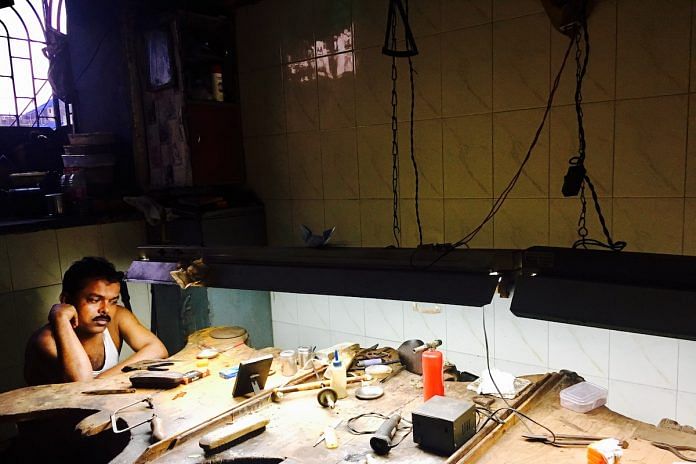Ahead of Diwali, jewellery showrooms in Zaveri Bazaar are unusually quiet as thousands of artisans go back home to West Bengal due to job cuts.
Mumbai: Dhanji Street, one of the busy crisscrossing alleyways of Mumbai’s landmark Zaveri Bazaar, is lined with creaking chawls on either side. Glossy showrooms displaying gold jewellery and glittering gems of every colour occupy the ground floors, while dark, narrow wooden staircases lead the way to cubbyhole workshops of artisans on the third and fourth floors.
Ten days before Diwali, the jewellery showrooms are unusually quiet and the small workshops meant for nearly 10 artisans now have only three or four workers carefully chiselling the tiny gems on a saddle-shaped wooden platform under the glare of a low-hung tube light.
Demand, they say, has plummeted due to an overall slump in the gems and jewellery business over the past two-three years, and demonetisation and the rollout of the Goods and Services Tax (GST) in quick succession have further throttled business.
“Two years ago, you wouldn’t have been able to step foot into the workshop around this time and I wouldn’t have had the time to say a single word to you. The room used to be packed with karigars (artisans) and people from showrooms discussing orders with us. The pressure during the festive season was immense,” said 51-year-old Laxmikant Dutta, an artisan himself and a small-time contractor for workers in Zaveri Bazaar.
Dutta, who moved to Mumbai from West Bengal’s Howrah district 37 years ago, used to manage six workers, but is now left with only one.
“There was no work. There was no money to pay them. They all left one by one. Overall in the industry, many karigars have gone back to Kolkata,” he said.
The gems and jewellery sector contributes 6-7 per cent to India’s GDP and employs approximately 3 million people. At the lowest rung of the industry’s supply chain are the artisans, who make the jewellery. A large number of them hail from West Bengal.
While there are no official figures of the number of such karigars across the country, industry players and artisans’ associations estimate that Mumbai itself was home to about 1-1.5 lakh artisans until about a year ago and thousands have left the city and the business over the past few months. The karigars either live in far-flung suburbs, outside the city limits such as Nalasopara and Bhayander, or sleep in the workshops in Zaveri Bazar to keep living expenses at a minimum.

Kalidas Babu, secretary of the Bengali Swarna Shilpa Kalyan Sangh, one such artisans’ association, said, “The situation has never been worse. Our association had 45,000 artisans registered with us. Now barely 20 per cent of them are still around.”
“When the going was good, every karigar would get work of about 500 grams a month at least. Now, it has dropped to 50 grams,” he said, adding, since their income is based on the making charges they earn per gram, the steep drop has made survival in an expensive city such as Mumbai a struggle.
Showroom owners say their revenues have dropped significantly compared with last year and so the quantum of orders to artisans has naturally reduced.
Also read:UP’s glittering brass and glass industries now dulled by job loss
Raman Solanki, director at Sangam Jewels N Gold and a member of governing board of directors of the All India Gems and Jewellery Trade Federation, said, “This is mostly an unorganised sector where systems are yet to fall in place post GST. The artisans used to earlier deal entirely in cash.”
“They now have to follow the norms of GST and are finding it very difficult. Also, there is a lot of ambiguity in the implementation of GST in this sector. The government needs to handhold the industry a bit,” Solanki said.
He said people were anyway wary of buying expensive jewellery post demonetisation and the government’s recent decision of making all receipts and payments KYC compliant for cash transactions of over Rs 50,000 had further spooked buyers.
“The showrooms are running empty. The retailers are not going to the wholesalers as much, and wholesalers are not approaching the karigarsas much. It’s simple. There is lesser work. There are fewer jobs,” Solanki added.



